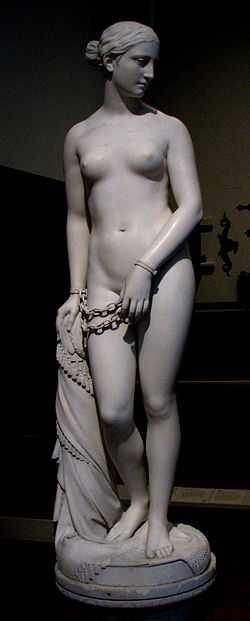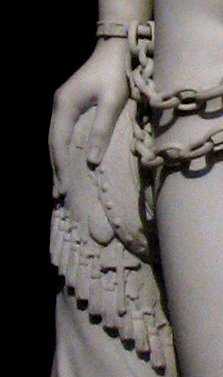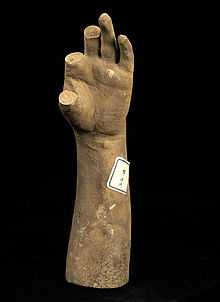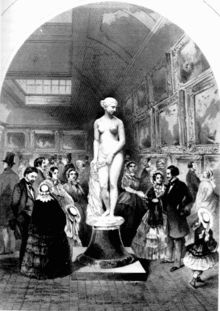The Greek Slave

The Greek Slave is a marble statue, originally sculpted in clay in Florence by American sculptor Hiram Powers.[1] This original sculpture was completed in 1844 and now resides in Raby Castle, England.[2] Copies of the statue were displayed in a number of venues around Great Britain and the United States, and it quickly became one of Powers' most famous and most popular works. The design of the statue was based upon the Venus de' Medici in the Uffizi Gallery in Florence.[3]
Subject
The statue depicts a young woman, nude, bound in chains; in one hand she holds a small cross on a chain. The title suggests that she is some sort of captive, and is on display for sale as a sexual object in an unknown market. Powers himself described the subject of the work thus:
The Slave has been taken from one of the Greek Islands by the Turks, in the time of the Greek revolution, the history of which is familiar to all. Her father and mother, and perhaps all her kindred, have been destroyed by her foes, and she alone preserved as a treasure too valuable to be thrown away. She is now among barbarian strangers, under the pressure of a full recollection of the calamitous events which have brought her to her present state; and she stands exposed to the gaze of the people she abhors, and awaits her fate with intense anxiety, tempered indeed by the support of her reliance upon the goodness of God. Gather all these afflictions together, and add to them the fortitude and resignation of a Christian, and no room will be left for shame.[4]


When the statue was taken on tour in 1848, Miner Kellogg, a friend of the artist and manager of the tour put together a pamphlet to hand out to exhibition visitors. He provided his own description of the piece:
The ostensible subject is merely a Grecian maiden, made captive by the Turks and exposed at Istanbul, for sale. The cross and locket, visible amid the drapery, indicate that she is a Christian, and beloved. But this simple phase by no means completes the meaning of the statue. It represents a being superior to suffering, and raised above degradation, by inward purity and force of character. Thus the Greek Slave is an emblem of the trial to which all humanity is subject, and may be regarded as a type of resignation, uncompromising virtue, or sublime patience.[4]
Reaction

Public reaction to the statue was mixed. When the work was first exhibited, many people were scandalized by the figure's nudity; Powers countered much of this criticism by suggesting that the young woman was a perfect example of Christian purity and chastity, because even in her unclothed state she was attempting to shield herself from the gaze of onlookers. Furthermore, he said, her nudity was no fault of her own, but rather was caused by her Turkish captors, who stripped her to display her for sale. So well did this reasoning work that many Christian pastors would exhort their congregations to go and see the statue when it was displayed.[3]
Some viewers also drew parallels between The Greek Slave and the slaves who were concurrently working on the plantations of the American South. Such parallels were initially lost upon much of the statue's American audience, but as the American Civil War neared, abolitionists began to take the piece as a symbol, and to compare it with "the Virginian Slave".[5] The comparison was the subject of a poem by John Greenleaf Whittier. The statue also inspired a sonnet by Elizabeth Barrett Browning. Abolitionist Maria White Lowell wrote that The Greek Slave "was a vision of beauty that one must always look back to the first time of seeing it as an era".[6] In 1848, while walking through Boston Common, Lucy Stone stopped to admire the statue and broke into tears, seeing in its chains the symbol of man's oppression of the female sex. From that day forward, Stone included women's rights issues in her speeches.[7]
Powers created six separate replicas of the Greek Slave. Each was made for sale to different art collectors. The Smithsonian American Art Museum holds one of the replicas, as does the Corcoran Gallery of Art in Washington, D.C.. Bought by founder William Wilson Corcoran in 1851, the replica is Hiram's first that was composed of full-size marble, like the original.[2]
When a copy was installed on the desk of the Governor in Vermont, Governor James Douglas ordered its removal as obscene, stating that schoolchildren might see it. [8][9] Other copies reside in the Vermont State House, at the Berkshire Museum in Pittsfield, Massachusetts, and the Westervelt Warner Museum of American Art in Tuscaloosa, Alabama.[10]
References
| Wikimedia Commons has media related to The Greek Slave. |
- ↑ Taft, Lorado (1903). The History of American Sculpture. Harvard University: Macmillan. p. 61.
- ↑ 2.0 2.1 "The Greek Slave". Corcoran. The Corcoran. Retrieved March 2, 2015.
- ↑ 3.0 3.1 "Hiram Powers' "The Greek Slave"". Assumption College. Retrieved 2006-11-20.
- ↑ 4.0 4.1 "Powers' "Greek Slave"". Uncle Tom's Cabin & American Culture. University of Virginia. Retrieved 2006-11-20.
- ↑ "University of Virginia". Uncle Tom's Cabin and American Culture. University of Virginia. Retrieved 2015-02-28.
- ↑ Wagenknecht, Edward. James Russell Lowell: Portrait of a Many-Sided Man. New York: Oxford University Press, 1971: 138.
- ↑ McMillen, Sally Gregory. Seneca Falls and the origins of the women's rights movement. Oxford University Press, 2008, p. 81. ISBN 0-19-518265-0
- ↑ Wren's Nest: Vermont Governor Wants Nude Statue Out Of Office
- ↑ Governor Wants Iconic Nude Off His Desk. New York Times December 12 2004
- ↑ Rawls, Phillip (July 2009). "Ala. ban of wine with nude label is marketing boon". The Boston Globe. Retrieved 2009-07-31.
Sources
- Lessing, Lauren (Spring 2010). "Ties that Bind: Hiram Powers’ Greek Slave and Nineteenth-century Marriage". American Art 24: 41–65. doi:10.1086/652743. Retrieved 31 March 2013.